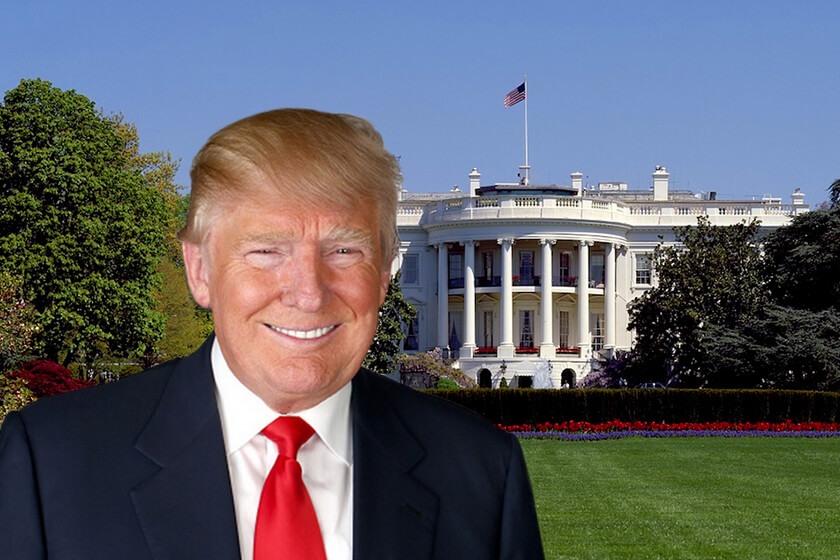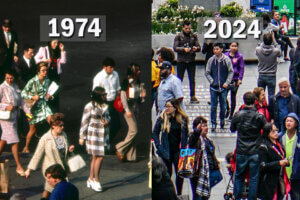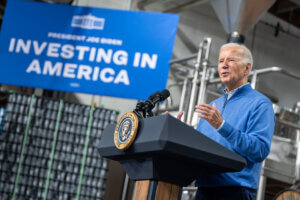West Long Branch, NJ – As Barack Obama exits the White House with solid job approval ratings, Donald Trump enters with a much more mixed set of expectations. This is particularly true when it comes to helping middle class Americans who are not expected to do as well as the already rich and powerful. The latest national Monmouth University Poll also finds the public is split on whether the new administration will be too friendly toward Russia.
Obama leaves office with a 56% approve and 38% disapprove job rating, which is in line with where his rating has stood since August. Prior to last summer, Obama’s second term job approval tended to hover in the low to mid 40s.
Trump takes the presidential oath this week with just 34% of Americans holding a favorable view of him and 46% having an unfavorable opinion. Another 20% are withholding judgment for now. The public is divided on Trump’s relationship with Russia. Just under half – 48% are concerned that he will be too friendly toward that country. An identical 48% of Americans, on the other hand, are not concerned about this. This is little changed from when Russian links to the DNC hacking were first raised during the campaign. Back in August, 45% of voters were concerned about Trump’s attitude toward Russia and 49% were not.
“The number of people with a positive view of Trump is about the same as it was throughout the fall campaign. However, negative views have declined from the high 50s last year as some of those critics have decided to take a wait-and-see approach as he takes the reins of power,” said Patrick Murray, director of the independent Monmouth University Polling Institute in West Long Branch, New Jersey.
The public is divided on just how much Trump’s presidency will help the middle class – 26% say a lot, 40% a little, and 29% not at all. This is not much different from public perceptions of how much the middle class has benefited from the outgoing Obama administration’s policy – 24% say a lot, 41% a little, and 33% not at all.
These nearly identical results mask some significant demographic differences within the American population though. For example, 32% of non-Hispanic white Americans expect Trump to help the middle class a lot versus 25% who say he not will help this group at all. However, only 17% of white Americans believe Obama helped the middle class a lot compared with 42% who say his policies did not help the middle class at all. Among non-white or Hispanic Americans, only 13% expect that Trump will help the middle class a lot and 36% say not at all, compared with 38% who say Obama helped the middle class a lot and just 14% not at all.
Americans across the racial spectrum are in agreement, though, on how much wealthy families will benefit from Trump’s policies. Fully 55% of the public – including 51% of whites and 63% of other Americans – believe that the wealthy will benefit a lot. Another 31% say the wealthy will benefit a little under Trump and just 7% say they will not benefit at all.
The results are similar for how much Trump is expected to help Wall Street bankers – 54% a lot, 30% a little, 7% not at all – and big business interests in general – 63% a lot, 27% a little, 4% not at all. By comparison, far fewer Americans feel that Obama’s policies provided a lot of benefit for the wealthy (29%), Wall Street (35%), and big business (30%).
“It is not clear whether the middle class will be better off than they are now when the dust settles on the Trump presidency, but the public is largely in agreement on who they think will be – the already rich and powerful,” said Murray.
One group that is expected to do worse under Trump is the poor. Just 21% of Americans believe that the new president’s policies will help poor families a lot, 36% say they will help the poor a little, and 37% say they will not help the poor at all. By comparison, 39% say that Obama’s policies have benefited the poor a lot, 36% a little, and 21% not at all.
Public opinion of the job Congress is doing continues to be overwhelmingly negative at 23% approve and 66% disapprove, although this is nominally better than the high-teens approval rating it received through most of the past few years. Similarly, just 29% of Americans feel the country is headed in the right direction while 65% say it is on the wrong track. This outlook is basically unchanged from prior polls in recent years.
“The nation’s fundamentally negative outlook suggests that the Trump administration will not enjoy a typical honeymoon period. At the same time, most Americans believe he will make an effort on policies to boost the middle class which was a central undercurrent of last year’s campaign,” said Murray.
In general, half of the country is optimistic about the policies Trump will pursue – including 24% who are very optimistic and 26% who are somewhat optimistic – while just over 4-in-10 are pessimistic (30% very and 13% somewhat). When it comes to specific policies to help the middle class, 61% say it is likely that Trump will propose these types of plans.
By comparison, when Obama made a pledge to focus on the middle class a few months after his re-election, 55% of the public felt that he would follow through on proposing those policies. There are some key partisan differences in this opinion between then and now. Today, 92% of Republicans and just 30% of Democrats believe Trump will propose policies to boost the middle class. In 2013, 84% of Democrats and 24% of Republicans thought Obama would propose such policies. Today, 65% of independents say Trump is likely to propose middle class policies. Four years ago, 50% of independents said the same about Obama.
Another thing that has changed in the past four years is whether Congress will cooperate to enact these proposals. Currently, a majority (54%) of Americans say it is likely that the legislative branch will ratify policies to help the middle class. In 2013, only 30% of the public had an expectation that Congress would take such action. The change has come mainly from Republicans – 82% believe Congress will enact middle class policies now compared to just 32% who felt that way four years ago. Independents are also more likely to expect Congress to act now (53%) than they were in 2013 (28%). Democrats’ expectations for Congressional action on helping the middle class, though, has not changed – 32% say it is likely today compared with 31% four years ago.
Extended commentary from Patrick Murray:
“Trump promised to drain the swamp, but it is not clear in which direction the sludge will flow. Americans do expect to see more proposals to help the middle class than they did during the Obama years, but there is a sneaking suspicion the ultimate beneficiaries will be those segments of society who already hold all the cards.
“The fact that Trump does not start with a wealth of goodwill and high expectations may actually work to his advantage as there may be less of a backlash if he fails. A number of voters supported Trump because they felt their concerns were totally invisible to government. To these Americans, Trump was seen as a last ditch effort to get the attention of those in power rather than some sort of white knight. Therefore, if their circumstances don’t change they may be more likely to shrug their shoulders than storm the barricades. Of course, this may be exactly what some in Trump’s inner circle are counting on.
“It is vitally important that we listen to the voices of middle America who feel they have been left behind precisely because they believe that we – public officials, the media, pollsters – are not paying attention to them. Giving voice to the public and holding those in power accountable has been a guiding principle for the Monmouth University Poll . Like many, we got caught up in the bizarre spectacle that was last year’s presidential election. However, our bread and butter has always been trying to channel the voice of the public on the concerns that matter to them the most. Indeed, many of the questions in this poll were taken from one we did four years ago as a reality check on Obama’s stated commitment to focus on the middle class. The public was skeptical then as now.
“We see it as our responsibility as pollsters to take our lead from what the public is telling us they are worried about and not necessarily what fleeting headlines the media or punditry is chasing at any given moment. As such, we are making a renewed commitment to focus a large segment of our polling output in the coming months and years on the bread and butter issues Americans face every day as well as the wedges that divide and threaten our civil society.”
The Monmouth University Poll was conducted by telephone from January 12 to 15, 2017 with 801 adults in the United States. The results in this release have a margin of error of ± 3.5 percent. The poll was conducted by the Monmouth University Polling Institute in West Long Branch, NJ.
QUESTIONS AND RESULTS
(* Some columns may not add to 100% due to rounding.)
1. Do you approve or disapprove of the job Barack Obama is doing as president?
| TREND: | Jan. 2017 | Sept. 2016* | Aug. 2016* | June 2016* | March 2016 | Jan. 2016 | Dec. 2015 | Oct. 2015 | Sept. 2015 | Aug. 2015 | July 2015 | June 2015 | April 2015 | Jan. 2015 | Dec. 2014 | July 2013 |
| Approve | 56% | 53% | 56% | 49% | 49% | 46% | 40% | 47% | 45% | 45% | 47% | 44% | 42% | 43% | 41% | 42% |
| Disapprove | 38% | 43% | 40% | 46% | 43% | 46% | 51% | 45% | 49% | 50% | 46% | 46% | 48% | 48% | 49% | 51% |
| (VOL) No opinion | 6% | 4% | 4% | 5% | 8% | 8% | 8% | 9% | 6% | 6% | 7% | 10% | 10% | 8% | 10% | 6% |
| Unwtd N | (801) | (802) | (803) | (803) | (1,008) | (1,003) | (1,006) | (1,012) | (1,009) | (1,203) | (1,001) | (1,002) | (1,005) | (1,003) | (1,008) | (1,012) |
* Registered voters
2. Do you approve or disapprove of the job the U.S. Congress is doing?
| TREND: | Jan. 2017 | Sept. 2016* | Aug. 2016* | June 2016* | March 2016 | Jan. 2016 | Dec. 2015 | Oct. 2015 | Sept. 2015 | Aug. 2015 | July 2015 | June 2015 | April 2015 | Jan. 2015 | Dec. 2014 | July 2013 |
| Approve | 23% | 15% | 14% | 17% | 22% | 17% | 16% | 17% | 19% | 18% | 18% | 19% | 21% | 18% | 17% | 14% |
| Disapprove | 66% | 77% | 78% | 76% | 68% | 73% | 73% | 71% | 71% | 72% | 69% | 71% | 67% | 70% | 73% | 76% |
| (VOL) No opinion | 11% | 8% | 9% | 7% | 10% | 10% | 10% | 12% | 11% | 11% | 12% | 10% | 12% | 11% | 11% | 10% |
| Unwtd N | (801) | (802) | (803) | (803) | (1,008) | (1,003) | (1,006) | (1,012) | (1,009) | (1,203) | (1,001) | (1,002) | (1,005) | (1,003) | (1,008) | (1,012) |
* Registered voters
3. Would you say things in the country are going in the right direction, or have they gotten off on the wrong track?
| TREND: | Jan. 2017 | Aug. 2016* | Oct. 2015 | July 2015 | June 2015 | April 2015 | Dec. 2014 | July 2013 |
| Right direction | 29% | 30% | 24% | 28% | 23% | 27% | 23% | 28% |
| Wrong track | 65% | 65% | 66% | 63% | 68% | 66% | 69% | 63% |
| (VOL) Depends | 4% | 2% | 6% | 5% | 5% | 5% | 5% | 5% |
| (VOL) Don’t know | 2% | 3% | 4% | 3% | 3% | 2% | 3% | 4% |
| (n) | (801) | (803) | (1,012) | (1,001) | (1,002) | (1,005) | (1,008) | (1,012) |
* Registered voters
4. Is your general impression of Donald Trump favorable or unfavorable, or do you have no opinion of him?
| Jan. 2017 | |
| Favorable | 34% |
| Unfavorable | 46% |
| No opinion | 20% |
| (n) | (801) |
5. Thinking about the next few years, do you feel optimistic or pessimistic about the policies Trump will pursue? [Is that very or somewhat optimistic/pessimistic?]
| Jan. 2017 | |
| Very optimistic | 24% |
| Somewhat optimistic | 26% |
| Somewhat pessimistic | 13% |
| Very pessimistic | 30% |
| (VOL) Don’t Know | 6% |
| (n) | (801) |
I’m going to ask you about how some different groups have done over the last few years.
[QUESTION GROUPS 6/7, 8/9, 10/11, 12/13 & 14/15 WERE ROTATED]
6. How much did middle class families benefit from President Obama’s policies – a lot, a little, or not at all?
| TREND: | Jan. 2017 | July 2013 |
| A lot | 24% | 12% |
| A little | 41% | 39% |
| Not at all | 33% | 46% |
| (VOL) Don’t Know | 2% | 2% |
| (n) | (801) | (1,012) |
7. And how much do you think middle class families will benefit from President Trump’s policies – a lot, a little, or not at all?
| Jan. 2017 | |
| A lot | 26% |
| A little | 40% |
| Not at all | 29% |
| (VOL) Don’t Know | 5% |
| (n) | (801) |
8. How much did wealthy families benefit from President Obama’s policies – a lot, a little, or not at all?
| TREND: | Jan. 2017 | July 2013 |
| A lot | 29% | 35% |
| A little | 43% | 31% |
| Not at all | 17% | 23% |
| (VOL) Don’t Know | 10% | 10% |
| (n) | (801) | (1,012) |
9. And how much do you think wealthy families will benefit from President Trump’s policies – a lot, a little, or not at all?
| Jan. 2017 | |
| A lot | 55% |
| A little | 31% |
| Not at all | 7% |
| (VOL) Don’t Know | 7% |
| (n) | (801) |
10. How much did poor families benefit from President Obama’s policies – a lot, a little, or not at all?
| TREND: | Jan. 2017 | July 2013 |
| A lot | 39% | 20% |
| A little | 36% | 39% |
| Not at all | 21% | 37% |
| (VOL) Don’t Know | 4% | 4% |
| (n) | (801) | (1,012) |
11. And how much do you think poor families will benefit from President Trump’s policies – a lot, a little, or not at all?
| Jan. 2017 | |
| A lot | 21% |
| A little | 36% |
| Not at all | 37% |
| (VOL) Don’t Know | 6% |
| (n) | (801) |
12. How much did Wall Street bankers benefit from President Obama’s policies – a lot, a little, or not at all?
| TREND: | Jan. 2017 | July 2013 |
| A lot | 35% | 44% |
| A little | 40% | 26% |
| Not at all | 11% | 14% |
| (VOL) Don’t Know | 15% | 17% |
| (n) | (801) | (1,012) |
13. And how much do you think Wall Street bankers will benefit from President Trump’s policies – a lot, a little, or not at all?
| Jan. 2017 | |
| A lot | 54% |
| A little | 30% |
| Not at all | 7% |
| (VOL) Don’t Know | 9% |
| (n) | (801) |
14. How much did big business interests benefit from President Obama’s policies – a lot, a little, or not at all?
| Jan. 2017 | |
| A lot | 30% |
| A little | 48% |
| Not at all | 14% |
| (VOL) Don’t Know | 8% |
| (n) | (801) |
15. And how much do you think big business interests will benefit from President Trump’s policies – a lot, a little, or not at all?
| Jan. 2017 | |
| A lot | 63% |
| A little | 27% |
| Not at all | 4% |
| (VOL) Don’t Know | 6% |
| (n) | (801) |
16. How likely is it that President Trump will propose policies to help the middle class – very, somewhat, not too, or not at all likely?
| TRUMP | OBAMA | |
| Jan. 2017 | July 2013* | |
| Very likely | 28% | 25% |
| Somewhat likely | 33% | 30% |
| Not too likely | 16% | 15% |
| Not at all likely | 21% | 29% |
| (VOL) Don’t Know | 2% | 1% |
| (n) | (801) | (1,012) |
*Trend from 2013 was asked regarding President Obama’s proposed policies
17. How likely is it that Congress will enact policies to help the middle class – very, somewhat, not too, or not at all likely?
| TREND: | Jan. 2017 | July 2013 |
| Very likely | 18% | 4% |
| Somewhat likely | 36% | 26% |
| Not too likely | 20% | 30% |
| Not at all likely | 24% | 38% |
| (VOL) Don’t Know | 2% | 2% |
| (n) | (801) | (1,012) |
18. On another topic, are you concerned or not concerned that Donald Trump will be too friendly toward Russia? [If CONCERNED: Is that a lot or a little concerned?]
| TREND: | Jan. 2017 | Aug. 2016* |
| Concerned, a lot | 33% | 32% |
| Concerned, a little | 15% | 13% |
| Not concerned | 48% | 49% |
| (VOL) Don’t Know | 3% | 3% |
| (n) | (801) | (803) |
* Registered voters
[Q19-35 held for future release]
METHODOLOGY
The Monmouth University Poll was sponsored and conducted by the Monmouth University Polling Institute from January 12 to 15, 2017 with a national random sample of 801 adults age 18 and older. This includes 400 contacted by a live interviewer on a landline telephone and 401 contacted by a live interviewer on a cell phone, in English. Monmouth is responsible for all aspects of the survey design, data weighting and analysis. Final sample is weighted for region, age, education, gender and race based on US Census information. Data collection support provided by Braun Research (field) and SSI (RDD sample). For results based on this sample, one can say with 95% confidence that the error attributable to sampling has a maximum margin of plus or minus 3.5 percentage points (unadjusted for sample design). Sampling error can be larger for sub-groups (see table below). In addition to sampling error, one should bear in mind that question wording and practical difficulties in conducting surveys can introduce error or bias into the findings of opinion polls.
| DEMOGRAPHICS (weighted) |
| Self-Reported |
| 30% Republican |
| 37% Independent |
| 33% Democrat |
| 49% Male |
| 51% Female |
| 31% 18-34 |
| 37% 35-54 |
| 32% 55+ |
| 67% White |
| 12% Black |
| 14% Hispanic |
| 7% Asian/Other |
Click on pdf file link below for full methodology and results by key demographic groups.




